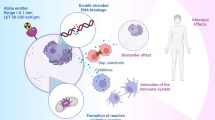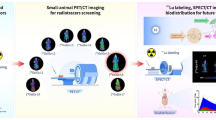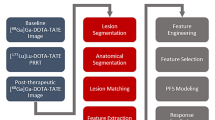Abstract
Malignant tumours have the remarkable property to express cell surface antigens. Pressman was first reporting that radiolabeled antibodies were capable of organ localization. It was a promising challenge but the expected success and the development of this imaging method was limited by a poor imaging resolution despite a rather good specificity of the antibodies used. Identification of key cell surface markers is opening a new era as potential molecular imaging biomarkers in oncologic applications. Antibodies production has been promoted by the development of engineered fragments with preserved immunological properties and pharmacokinetics optimized for molecular imaging. A good compromise has to be obtained between the biological properties of the antibody and the physical half-life of the radionuclide. Several positron emission tomography (PET) radionuclides such as iodine-124, copper-64, yttrium-86 or zirconium-89 have been the focus of recent immuno-PET studies with interesting informative images in preclinical and clinical studies. Thanks to the development of more sensitive new detectors and specific software, molecular imaging methods, particularly PET imaging, allow nowadays the detection of lesions smaller than 5 mm in human. Immuno-PET can potentially be used for tumour detection and identification at diagnosis, staging and restaging, for treatment selection and monitoring, and during follow-up. Moreover the availability of matched imaging or therapeutic radionuclide pairs, such as 124I/131I, 64Cu/67Cu and 86Y/90Y, make easier the quantification of tissue uptake and dosimetry calculation for radioimmunotherapy.




Similar content being viewed by others
References
Ehrlich P (1900) Croonian lecture: on immunity with special reference to cell life. Proc R Soc Lond 66:424–448
Boswell CA, Brechbiel MW (2007) Development of radioimmunotherapeutic and diagnostic antibodies: an inside-out view. Nucl Med Biol 34:757–778
Goldenberg DM, DeLand F, Kim E, Bennett S, Primus FJ, van Nagell JR Jr, Estes N, DeSimone P, Rayburn P (1978) Use of radiolabeled antibodies to carcinoembryonic antigen for the detection and localization of diverse cancers by external photoscanning. N Engl J Med 298(25):1384–1386
Johnson VG, Schlom J, Paterson AJ, Bennett J, Magnani JL, Colcher D (1986) Analysis of a human tumor-associated glycoprotein (TAG-72) identified by monoclonal antibody B72.3. Cancer Res 46:850–857
DeJager R, Abdel Nabi H, Serafini A, Pecking AP, Klein JL, Hanna MG Jr (1993) Current status of cancer immunodetection with radiolabeled human monoclonal antibodies. Semin Nucl Med XXIII 2:165–179
Wu AM, Olafsen T (2008) Antibodies for molecular imaging of cancer. Cancer J 14:191–197
Nuttall SD, Walsh RB (2008) Display scaffolds: protein engineering for novel therapeutics. Curr Opin Pharmacol 8(5):609–615
Orlova A, Magnusson M, Eriksson TL et al (2006) Tumor imaging using a picomolar affinity HER2 binding affibody molecule. Cancer Res 66:4339–4348
Holliger P, Hudson PJ (2005) Engineered antibody fragments and the rise of single domains. Nat Biotechnol 23:1126–1136
Sundaresan G, Yazaki PJ, Shively JE et al (2003) 124I-labeled engineered anti-CEA minibodies and diabodies allow high-contrast, antigen-specific small-animal PET imaging of xenografts in athymic mice. J Nucl Med 44:1962–1969
Santimaria M, Moscatelli G, Viale GL et al (2003) Immunoscintigraphic detection of the ED-B domain of fibronectin, a marker of angiogenesis, in patients with cancer. Clin Cancer Res 9:571–579
Pecking AP, Gougeon-Bertrand FJ, Lokiec FM et al (1996) Radioimmunolymphoscintigraphy in the preoperative staging of primary breast cancer: a pilot study using a human monoclonal antibody (LiLo 16.88). Int J Oncol 9:659–667
Decaudin D, Levy R, Lokiec F, Morschhauser F, Djeridane M, Kadouche J, Pecking A (2007) Radioimmunotherapy of refractory or relapsed Hodgkin’s lymphoma with 90Y-labelled antiferritin antibody. Anticancer Drugs 18:725–731
Pauwels EK, Ribeiro MJ, Stoot JH, McCready VR, Bourguignon M, Mazière B (1998) FDG accumulation and tumor biology. Nucl Med Biol 25:317–322
Hoh CK, Schiepers C, Seltzer MA, Gambhir SS, Silverman DH, Czernin J, Maddahi J, Phelps ME (1997) PET in oncology: Will it replace the other modalities? Semin Nucl Med 27:94–106
Larson SM, Schoder H (2009) New PET tracers for evaluation of solid tumor response to therapy. Q J Nucl Med Mol Imaging 53:158–166
Divgi CR, Bander NH, Scott AM et al (1998) Phase I/II radioimmunotherapy trial with iodine-131-labeled monoclonal antibody G250 in metastatic renal cell carcinoma. Clin Cancer Res 4:2729–2739
Divgi CR, Pandit-Taskar N, Jungbluth AA et al (2007) Preoperative characterisation of clear-cell renal carcinoma using iodine-124-labelled antibody chimeric G250 (124I-cG250) and PET in patients with renal masses: a phase I trial. Lancet Oncol 8:304–310
Pryma DA, O’Donoghue JA, Humm JL, Jungbluth AA, Old LJ, Larson SM, Divgi CR (2011) Correlation of in vivo and in vitro measures of carbonic anhydrase IX antigen expression in renal masses using antibody 124I-cG250. J Nucl Med 52:535–540
Alberini JL, Edeline V, Giraudet AL, Champion L, Paulmier B, Madar O, Poinsignon A, Bellet D, Pecking AP (2011) Single photon emission tomography/computed tomography (SPET/CT) and positron emission tomography/computed tomography (PET/CT) to image cancer. J Surg Oncol 103:602–606
Manjeshwar R, Ross S, Iatrou M, Deller T, Stearns C (2006) Fully 3D PET iterative reconstruction using distance-driven projectors and native scanner geometry. IEEE Nucl Sci Symp Conf Rec 5:2804–2807
Iatrou M, Manjeshwar R, Ross S, Thielemans K, Stearns C (2006) 3D implementation of scatter estimation in 3D PET. IEEE Nucl Sci Symp Conf Rec 5:2142–2145
Stearns CW, McDaniel DL, Kohlmyer SG, Arul PR, Geiser BP, Shanmugam V (2003) Random coincidence estimation from single event rates on the Discovery ST PET/CT scanner. In: Conference record of the 2003 IEEE nuclear science symposium and medical imaging conference, Portland
Alessio A, Stearns CW, Tong S, Ross SG, Kohlmyer S, Ganin A, Kinahan PE (2010) Application and evaluation of a measured spatially variant system model for PET image reconstruction. IEEE Trans Med Imaging 29(3):938–949
Aschheim S, Zondek B (1928) Das Hormon des Hypophysenvorderlappens. II. Klinische Wochenschrift, Berlin 7:831–835
Van Dongen GA, Vosjan MJ (2010) Immuno-positron emission tomography: shedding light on clinical antibody therapy. Cancer Biother Radiopharm 25(4):375–385
Conflict of interest
None.
Author information
Authors and Affiliations
Corresponding author
Rights and permissions
About this article
Cite this article
Pecking, A.P., Bellet, D. & Alberini, J.L. Immuno-SPET/CT and immuno-PET/CT: a step ahead to translational imaging. Clin Exp Metastasis 29, 847–852 (2012). https://doi.org/10.1007/s10585-012-9501-5
Received:
Accepted:
Published:
Issue Date:
DOI: https://doi.org/10.1007/s10585-012-9501-5




